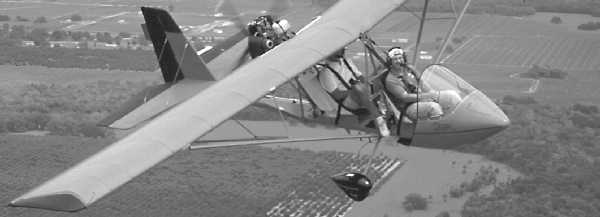
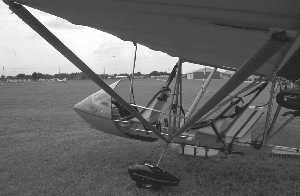
NEW STRUTS – The struts make the new Drifter SB (for strut-braced) stand out compared to the kingpost and cable-braced models of yesteryear, but many other refinements have also been added from the “land down under.”
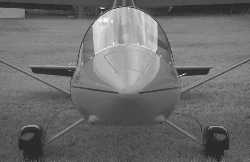
BIG AND CLEAN – Bearing more than a faint resemblance to the Explorer and Zephyr (no surprise – they emulated the Drifter), the Ausflight Drifter is a beefy airplane big guys will love.
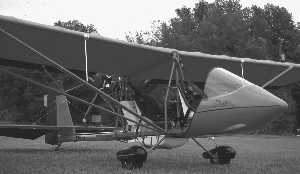
OLD AND NEW – The Ausflight version of the Drifter brings back to the U.S. this once-popular aircraft. The big difference? Aussie certification and struts.
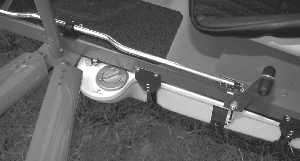
FUEL CELL – It’s a little hard to read but the placard near the fuel fill cap says “Fuel: Neat Petrol Only” (Neat Petrol is Aussie-speak for regular unleaded autogas).
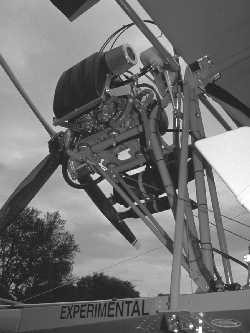
WELL-SUPPORTED – The Rotax 66-hp 582 2-cycle engine had plenty of support from this newly designed engine mount system that differs noticeably from the older Drifter models.
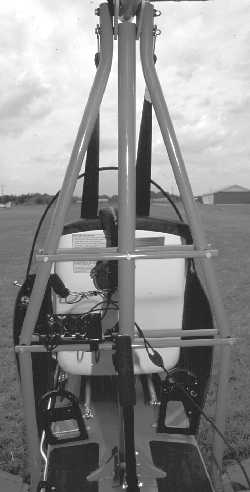
REAR VIEW – For a tandem aircraft, this new Drifter excels in giving the aft seat pilot about as much visibility as the front seat in many ultralights.
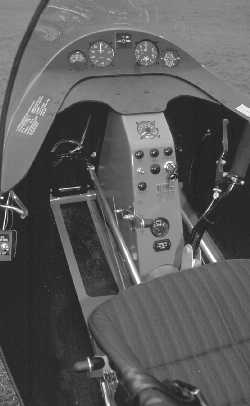
DELUXE COCKPIT – Even a Bonanza driver would have to love this aerial animal, featuring as it does many sophisticated items such as a low-fuel warning light to help you keep track of the details.

HAPPY MAN – We forced him to smile for the camera (hard work for lots of factory pilots) but Randy Brown smiled all the time when people gave him their reaction to this slick bird.
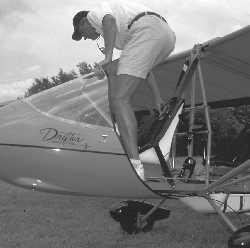

PREFERRED SEATING – Now, I’d say that entry to this aircraft is among the easiest, so long as you can maneuver up high enough, as demonstrated by Tiger Aviation’s Randy Brown. Note his confident use of the windscreen as a handhold.
One-time Aussie distributor Chris Blackwell claimed sales in excess of 200 units – and this was the American-produced version from the Maxair company. It proved no impediment that Drifter kits had to be shipped halfway around the Earth to reach the land of kangaroos.
Sometime after this illustrious and energetic time, things went south for Maxair in more than just a financial way. Through a labyrinth of twists and turns, a Florida man named Don Jones ended up owning the one-time Pennsylvania company in a set of circumstances most charitably called “questionable.” At best, he kept the design alive. At worst, he sunk the design into near oblivion.
Fortunately, good things tend to stick around, regardless of how badly they’re treated. The Drifter is an example.
Perhaps because the Drifter made it to Australia in large numbers, the ’97 incarnation of the tandem aircraft now returns from the country on the bottom side of the globe. Ausflight is the company name now and, indeed, it’s back up from “down under.”
The Wing is the Thing
With several hundred very nice aircraft to choose from, why would someone want to resurrect this aging design? Actually, it isn’t hard to understand.
First, the wing is the thing. Another output from famed ultralight designer Klaus Hill (Hummer, Humbug, Hummingbird, Pterodactyl, Weedhopper and SuperFloater, among others), the Drifter started out with a variation of wing design from this master of slow-speed flight. At a time when the industry knew precious little about slow-speed lightweight wing design, Hill stood out as a giant among designers. When something works, a smart company tends to stick with it.
Second, the way master toolman Denny Franklin (of Maxair) built things, they tended to stay together even under abusive conditions. Now employed by Leza-Lockwood, Franklin remains a great talent in this industry, and the length of time the Drifter has lasted is a further testament to his early labors. One reason the Aussies liked the Maxair Drifter was precisely because it was tough.
Third, it was fun. Lots of fun. You flew just ahead of your airplane. Seated well out in front of the wing, the Drifter allowed flight few had experienced.
Fourth, the Drifter in its 2-seat configuration was a good flying ultralight that could handle big occupants and give them a great view with reasonably good aerodynamic efficiency.
Fifth, the Maxair boys knew how to have a gas with their birds. They made an intriguing little single-seat Drifter with a clipped wing and a big honking engine and called it the Little Red Rocket. Ahead of its day, it was the equivalent of the Kolb SlingShot mated to an Air Cam. Every media writer who flew the Rocket gushed with enthusiasm. How could they not? It was extreme fun!
Fast Forward to the Future
It should come as no surprise the Drifter SB of today is much more sophisticated. It’s also certificated in Australia. With sophistication and certification comes respectability. In addition, weight goes up along with price and, well, we’re getting ahead of ourselves here.
Let’s just go fly the Drifter SB and you’ll see what I think. Then you can make your own judgments.
I flew with tall lanky Randy Brown. Randy is with Tiger Aviation, the U.S. representative for Ausflight. Ausflight is the “down under” manufacturer and Australian airworthiness certificate holder.
Since I haven’t made a thorough study of the Australian certification program, I can’t relate many details (which you’d probably find dull anyway). However, I’ve had enough conversations with those who worked to meet those standards to know it’s a darn tough program. Though Cessna might disagree, I’m told it matches up fairly well to the same Part 23 standards they use to build Citation jets.
You don’t need to know the details. You only need to know that since the Drifter SB has passed Aussie muster on certification, the plane is very likely to behave as it should. That’s good, even if it does bump up the price to cover the cost of such a big effort.
The “SB” tagged on the hindquarters of “Drifter” means strut-braced. This may be the most noticeable change, but it certainly isn’t the only one.
Brown said the wing has been beefed up throughout to meet those Australian standards. Wing attach points are also stronger. The engine mount is now a chromoly steel arrangement, ostensibly far stronger than the Maxair aluminum version. It had better be since one of the options you can choose is the 80-hp Jabiru 2200 engine, also developed in Australia.
The pilot enclosure is bigger and higher, making it look more like the Explorer and Zephyr which were developed as a virtual knockoff of the original Drifter.
Fuel on our test Drifter included a 5-gallon seatback tank, plus a 10-gallon belly-mounted tank (both standard features). With the weight and size increase, the landing gear has been strengthened; the tailwheel is a tougher component as well.
From the pilot’s seat, the Drifter felt very solid throughout all flight maneuvers with only modest flexing way out at the tips. It felt like the tough beast I always thought it was, but now I had the benefit of knowing some nit-picking bureaucrat had also gone over the aircraft with a magnifying glass.
Loaded to the Max
As soon as Randy Brown invited me with that big smile of his, I scrambled into the front seat and let him show me around. It takes a few minutes to review the features. Ausflight has chosen to make the Drifter SB an aircraft that general aviation pilots might buy.
To prove the point, the basic plane comes with a host of standard items; among them are low-fuel and low-oil lights – regular idiot lights of the aviation world. (I admit I rather liked having them. Hey, they can’t hurt and they don’t weigh much.)
In addition, the Drifter SB has, count ’em, three fuel supply devices: the basic Rotax fuel pump, an electric pump and an electric primer in case systems one and two go down. Even the Bonanza I flew with its six fuel cells didn’t have this many fuel pump devices.
Whatever Ausflight did, it seems to work. For example, I noted that temperature gauges didn’t vary widely, not increasing much while climbing, nor cooling quickly while descending. This speaks well of the cooling system and installation. By the way, none of those idiot lights came on.
Some things I could still fuss about: The trim system wasn’t entirely to my liking. I couldn’t seem to get it to either extreme range and it didn’t feel quite like it was working as hard as it might. The brake handle on the front of the joystick is very comfortable to ultralight pilots, but general aviation guys will probably wonder if it’s some crazy tow release or something.
Later in the flight, my experience showed that a throttled-back flight attitude produced about 40 mph, which suggests the trim was working better than I thought at first. Perhaps I simply couldn’t tell when I’d been up at a higher altitude.
As in the old Drifter, you sit well out in front of the wing. My head was probably a good 12 inches in front of the leading edge. Of course, this also means you don’t have the wings as a usual reference to keep a level attitude. I found it no problem, but some pilots may miss the reference. In truth, I love sitting in this position. The visibility. Oh, man!
I ended up flying dual and using just my baseball cap and headset – a situation I don’t care for in an open cockpit aircraft. (I’d loaned my helmet out at the time and anyway needed to communicate with Brown in the back seat using his headset system.) I was getting hit with some wind in the forehead which had a tendency to lift my hat off. It was distracting, and I much preferred my later solo flight after getting back my trusty helmet. It also did a better job of blocking the noise.
Engine vibration is very mild, as Brown said it would be, thanks to the new engine mount arrangement. However, this didn’t do anything about the engine noise. I could still hear it quite audibly and that’s even with a 4-blade prop (which should reduce noise somewhat).
These complaints are easily remedied by procuring a good helmet with built-in headsets.
Getting Gone
Takeoff and landing were both recommended at 50 knots, equating to 58 mph. As some reinforcement of my feeling that the bird was on the heavy side (550 pounds empty), the speeds had to be higher.
On two of my landings while dual with Randy, I touched the tailwheel first. He indicated I would not have this situation when solo. He turned out to be right. The dual landing trick is to virtually not flare but rather set up an attitude landing.
While visually inspecting the aircraft before flight, slips didn’t look like they’d be particularly effective due to the lack of side area. However, the controls allowed me to get her cranked up sideways, and this indeed produced a very reasonable slipping descent.
A certain amount of momentum can be felt at the tail while taxiing, giving the Drifter SB some ground loop potential. In compensation, the two or three landings I did tailwheel-first proved the structure to be very solid, unchallenged by my poor technique.
All my landings were made, by the way, in nearly a 90° crosswind. Most of the time the winds were light, but still this adds drift you must counteract. I had no difficulty maintaining control even while doing my first operations in this plane.
Ausflight’s version of the Drifter continues to use full-span ailerons. Flaps are an option.
This Drifter’s rudder pedals and throttle were on the stiff side. These are friction-related things, and I guess I’d rather have them too stiff than not stiff enough. Throttle and trim levers that stay where you put them are desirable.
The throttle is located down and low which is easy enough to reach but causes you to have your arm rather extended. This means you have a somewhat awkward leverage position when moving the throttle which didn’t permit the smoothest motions. Considering the throttle stiffness, my inputs were a tad erratic.
The roll rate was quite good – not fast, but authoritative and reliable. I guess this is as it should be with that airworthiness certificate all shiny and new.
It took a fair amount of extra power to get the Drifter to hold altitude in 720° steep turns. In addition, I found a good amount of back pressure was required, but I was unable to get the trim back far enough to help hold up the nose, so this influenced my perception.
A most interesting discovery was that handling seemed to improve when solo versus dual. This was true by quite a demonstrable amount. Single-seaters always outhandle their 2-seat siblings, but 2-seaters usually stay more ponderous even when one up.
Climb rate on the Drifter SB was about 600 feet per minute while dual. The climb rate was of course better when solo. I didn’t make a note, but an exhilarating angle proved the point just as well.
She held altitude at 5,200 rpm when dual, which produced a little more than 55 mph. When solo, I could hold altitude at 4,800 rpm at about 50 mph. For the size of this aircraft, these are pretty efficient numbers. Since climb was less impressive and the takeoff done at faster speeds, I’d say the wing has been optimized for flight in the 60 mph range, not at lower ultralight speeds.
Brown claims glide is about 10-to-1 and my experience backed this up with the need on several approaches to slip to get down to a good path to landing. My checks of sink rate showed only somewhat better than average performance.
When I soloed with the throttle back all the way (which turned out to be about 2,600 rpm), the Drifter’s sink rate appeared to be pretty fair at about 400 fpm. For an aircraft of this size and weight, this is quite good and shores up the claim of a good glide, the two being somewhat linked. Especially considering a mere 30-foot span wing with 156 square feet, the big Drifter SB performed quite well, a testament to that old Klaus Hill wing design of many years ago. Admittedly, though, all these maneuvers were done at higher speeds. At more typical ultralight speeds (35 to 50 mph), the sink may have been higher and the glide less.
No complaints could be uncovered in the stability department. Stall occurred in the mid-30-knot range (35 mph), which is solidly within the ultralight range. All variations of stall were very mild responding, including power-on, power-off and accelerated.
Not only were the stalls mild, but no rollout occurred in accelerated stalls. It just bucks around a little, telling you what is happening. These are excellent characteristics for beginner or expert alike.
Snagging a Drifter SB
Getting your own Drifter SB is easier than you’d think.
First, Tiger Aviation, based in central Florida, handles all the import stuff. You deal with an American company, who will also service the airframe. Since they use the Rotax 582, that service can be obtained across the U.S. (Should you choose the Jabiru, Tiger Aviation is the U.S. rep for that engine.)
Second, the Drifter SB is sold in two ways, according to Tiger Aviation: a 100-hour assembly kit, or fully assembled and test-flown. Since only $2,000 separates the two, I believe many Americans will choose ready to go.
Now as you might imagine, that isn’t as simple as it might be in the U.S., where amateur-built rules govern aircraft like the Drifter. However, Randy Brown can present the plan they have for amateur-building, which sounded pretty reasonable. I hesitate to describe it here because these things have a squirrelly way of changing, so you should directly question Tiger Aviation.
The basic kit sells for $21,500 with the ready-to-fly version at $23,500. Yes, the price tag is on the steep side for an ultralightlike design, but check the list of standard equipment. Outfit many American designs this way and you’ll end up with a similar price. The real question is, “Do you want or need all this?”
The kit and fully built include the following “extras” as standard features: full-size pod with large windscreen, 5- and 10-gallon fuel tanks, electric start, battery, 4-blade prop, E gearbox, wheel pants, mechanical drum brakes, electric fuel pump, electric primer, full instruments, after-muffler and intake silencer, and low-fuel and low-oil warning lights. This is one of the most complete standard equipment lists I’ve seen among ultralightlike aircraft.
In fact, the only options you can add (for now) are the 80-hp Jabiru 2200 4-stroke engine, amphibious floats and flaps. All things considered, the price seems fair.
Given the wonderful reputation of this plane, the thoroughness of construction under the new owners and the Australian certification, I’d have to rate the Drifter SB a fine buy. If you want a big beefy plane that can do some serious duty, call Tiger Aviation and review your ownership options. It’ll keep that smile on Randy Brown’s face.
| Seating | 2, tandem |
| Empty weight | 550 pounds |
| Gross weight | 1,100 pounds |
| Wingspan | 30 feet |
| Wing area | 156 square feet |
| Wing loading | 7.1 pounds/sq ft |
| Length | 19 feet 6 inches |
| Height | 7 feet |
| Load Limit | +6 Gs, -4 Gs |
| Fuel Capacity | 15 gallons |
| Kit type | Assembly |
| Build time | 100 hours |
| Standard engine | Rotax 582 |
| Power | 66 horsepower |
| Power loading | 16.7 pounds/hp |
| Max Speed | ? mph |
| Cruise speed | 74 mph |
| Stall Speed | 36 mph |
| Never exceed speed | ? mph |
| Rate of climb at gross | 800 fpm |
| Takeoff distance at gross | 350 feet |
| Landing distance at gross | 350 feet |
| Standard Features | 66-hp Rotax 582 2-cycle engine, electric start, electric primer, E gearbox, 4-blade ground-adjustable prop, dual controls, steerable tailwheel, 4-point pilot restraints, cockpit pod, windshield, in-flight elevator trim, strut-braced wings, intake silencer, after-muffler, mechanical drum brakes, heavy-duty landing gear, 15-gal fuel capacity, fuel on-off selector, full instrumentation, low-fuel and low-oil warning indicators, wheel pants. Certified to Australian standards. |
| Options | 80-hp Jabiru 2200 4-stroke engine, flaps, amphibious floats, fully assembled option. |
| Construction | chromate-coated aluminum tubing, AN hardware, Dacron fabric covered. |
Design
Cosmetic appearance, structural integrity, achievement of design goals, effectiveness of aerodynamics, ergonomics.
Pros – Well-recognized design with good record and popularity; now done to full Australian certification, which adds a comfort level for many buyers. Struts give a new look (old Drifter was kingpost and cable-braced). Design has proven durability, both in field operations and how long it’s endured. Comfortable for big pilots. Carries a lot (550 pounds useful load).
Cons – Struts are actually heavier (yet not necessarily stronger). Aircraft gained weight over time and for certification. Price also rose with the weight. Made out-of-the-USA, a holdback for some potential buyers. Can’t make Part 103 training exemption weight (496 pounds empty) as test-flown for this report.
Systems
Subsystems available to pilot such as: Flaps; Fuel sources; Electric start; In-air restart; Brakes; Engine controls; Navigations; Radio; (items covered may be optional).
Pros – You want ’em, the Drifter SB has ’em. General aviation pilots considering an ultralightlike design will find lots to love, even including low-fuel and low-oil warning lights. Large mechanical drum brakes that worked quite well. Electric start standard. Triple fuel pump-type systems. Easy engine access for repairs.
Cons – No standard flaps (they’re an option); not needed particularly, but somewhat expected on such a refined design. Brakes are unidirectional. Trim and throttle both on stiff side (though better too stiff than too loose). Throttle requires more arm leverage than a more conveniently placed lever. Dual tanks (5-gallon seatback tank plus 10-gallon belly tank) require some additional attention to where quantities remain.
Cockpit/Cabin
Instrumentation; Ergonomics of controls; Creature comforts; (items covered may be optional).
Pros – Grand front seat; you feel comfortable, protected and has arguably the best visibility of any aircraft I’ve ever flown – the Drifter has long set this standard. Entry is easy from a standpoint of its openness. Reach to controls, throttle and pedals felt excellent to me. Very good panel readability. Proper, appreciated 4-point pilot restraints front and rear.
Cons – Front seat entry complicated slightly by how high the seat sits. No cargo area (unless rear seat unoccupied). Seats do not adjust. No cabin enclosure possible, potentially restricting acceptance in colder climates.
Ground Handling
Taxi visibility; Steering; Turn radius; Shock absorption; Stance/Stability; Braking.
Pros – Taxi visibility, at least from the front, simply can’t get any better than this. Tailwheel steering felt precise and allowed fairly tight maneuvering. Stance was highly stable and gear seemed brute strong. Brakes did a credible job of slowing the big Drifter SB. Lots of clearance for rougher field operation.
Cons – Tail felt somewhat ponderous, like it could get into a ground loop if poor technique was used, though I experienced no problems whatsoever. Nondifferential brakes no help in very tight maneuvering. No true suspension – just gear-leg flex and air in the tires. Rudder pedal stiffness slightly affected smoothness of taxi turning.
Takeoff/Landing
Qualities; Efficiency; Ease; Comparative values.
Pros – Both launch and land operations were very straightforward. Man, that visibility! You can see the whole world! Surprisingly good glide and sink rate (for such a big plane); gives comfort should the engine sputter – which it did not. Slips effective considering no side fuselage area.
Cons – Takeoff roll longer than on older, lighter Drifters. Takeoff and landing speeds recommended at 57 mph, a little fast.
Control
Quality and quantity for: Coordination; Authority; Pressures; Response; and Coupling.
Pros – Control harmony was good. Roll rate wasn’t fast but was adequately authoritative for any operations. Steep turns carved smoothly. All landings done in light 90° crosswinds without any difficulty. Aircraft is highly predictable in all control modes, no doubt easing Australian certification efforts and making it a good training aircraft.
Cons – Rather stiff rudder pedals confounded my Dutch rolls a bit. Steep turns needed fair amount of back pressure (though this may be my unfamiliarity with proper use of the trim lever). On whole, the plane felt rather heavy – as it is – which for me detracted slightly from the overall experience.
Performance
Climb; Glide; Sink; Cruise/stall/max speeds; Endurance; Range; Maneuverability.
Pros – Sped right along at an easy 75 mph, though slower speed cruise was also easy and efficient. Glide and sink rates were both much stronger than I anticipated. Climbed very well solo with the Rotax 582 engine. Able to sustain altitude at only 4,800 rpm when solo and only 5,200 when dual – quite good numbers.
Cons – Not the fastest plane in the sky, maxing out at about 85 according to the installed ASI. Climb was a tad on the weak side when dual (probably why the 80-hp Jabiru 4-stroke engine is offered as an option – and it’s 10 pounds lighter than the 582, according to Tiger Aviation). Overall size and weight limited slow flight.
Stability
Stall recovery and characteristics; Dampening; Spiral stability; Adverse yaw qualities.
Pros – Wonderful stall characteristics; the most I was ever able to wring out of the Drifter SB was a slight shuddering at stall. Accelerated stalls simply would not roll out radically. Longitudinal stability was very solid. Adverse yaw was on the light side of average. Extremely solid construction would seem to give great crash protection. Good emergency landing clearance and robustness.
Cons – A high-mounted engine had the usual effect of pushing the nose down on power-up (opposite of most general aviation certified aircraft), but not a problem. No other negatives uncovered.
Overall
Addresses the questions: “Will a buyer get what he/she expects to buy, and did the designer/builder achieve the chosen goal?”
Pros – Over 1,000 Drifters are flying, for good reason: this design enjoys a good safety and operation record. Ausflight’s version with struts appears to improve both characteristics. Certification in one of world’s toughest programs will assure many buyers. Wonderfully well-equipped as standard. Big and comfortable for almost any pilot. Fully assembled version available.
Cons – With certification came increased weight – good for durability and strength though handling suffered a little. As test-flown, cannot meet Part 103 ultralight trainer weight exemption – an FAA pilot’s license is required.


Leave a Reply